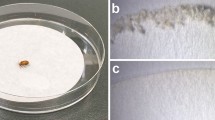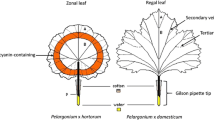Summary.
In earlier investigations on host plant discrimination of leaf beetles glucosinolates were described as feeding stimulants for the Brassicaceae specialist Phaedon cochleariae F. (Coleoptera: Chrysomelidae). However, since these findings could not be confirmed in later studies offering 2-propenylglucosinolate in concentrations corresponding to those detected in host plant leaf material, the identification of feeding stimulants of this leaf beetle species remained unclear. In order to investigate which compounds of the host plant Sinapis alba (Brassicaceae) are involved in feeding stimulation, leaf extracts of different polarities were tested in bioassays with adults of P. cochleariae. Number of feeding beetles and net consumption rates were highest on pea leaves painted with methanol extracts of S. alba, whereas weak feeding responses were also detectable for hexane extracts. In subsequent bioassay-guided fractionations of methanol extracts with semi-preparative high performance liquid chromatography, two distinct fractions, one containing glucosinolates and another containing flavonoids, were found to stimulate beetles to feed to variable degrees. Other collected fractions had zero activity. The combination of both active fractions evoked significantly higher consumption rates and stimulated more beetles to feed than fractions tested individually. At least one compound of each fraction, among these the main glucosinolate of S. alba, 4-hydroxybenzylglucosinolate, act additively. Effects of two different naturally-occurring ratios of glucosinolates and flavonoids on the strength of feeding responses were investigated by use of extracts of two sets of host plants differently exposed to radiation. One set was outdoors-exposed, whereas the second set was kept in the greenhouse. However, the feeding behaviour of P. cochleariae was not affected by the significantly different relative compositions of both compound classes in the host material. In conclusion, mustard leaf beetles need a combination of distinct plant metabolites acting in concert for feeding stimulation, whereby the mere presence of these stimulants, but probably not the ratio of involved compounds, determines their feeding response.
Similar content being viewed by others
Author information
Authors and Affiliations
Corresponding author
Rights and permissions
About this article
Cite this article
Reifenrath, K., Müller, C. Multiple feeding stimulants in Sinapis alba for the oligophagous leaf beetle Phaedon cochleariae . Chemoecology 18, 19–27 (2008). https://doi.org/10.1007/s00049-007-0389-5
Received:
Accepted:
Published:
Issue Date:
DOI: https://doi.org/10.1007/s00049-007-0389-5




